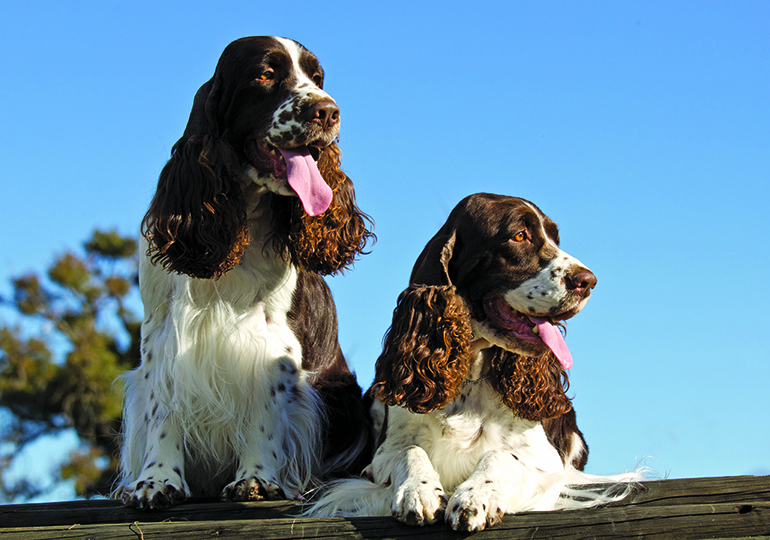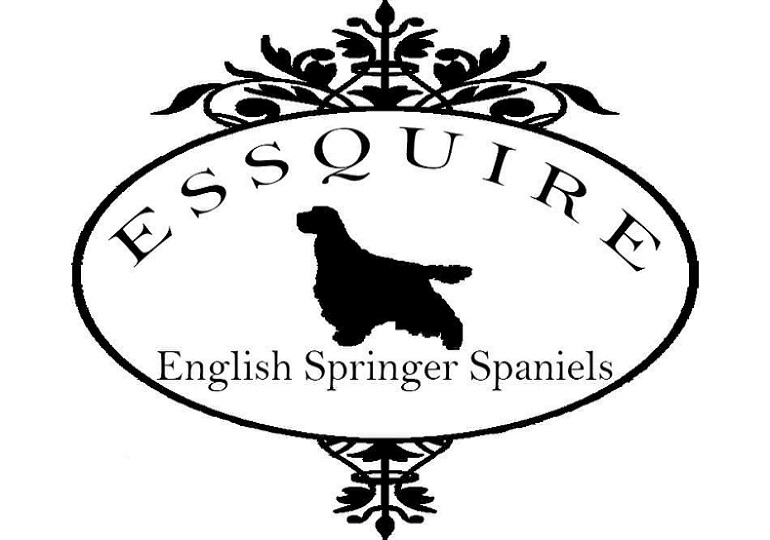Breeds
English Springer Spaniel

GROUP 3 - GUNDOGS
History
Although the exact origin of the English Springer Spaniel is not known, it is generally agreed that, like all spaniel breeds, their first home was in Spain and perhaps introduced to ancient Britons by the Roman legions.
The term “springer” was originally used to describe all land spaniels. The dog was used to spring (flush) or start game for the net, falcon or greyhound. Spaniels of a particular size or weight were developed to suit either the type of game that they were required to hunt, or the type of terrain they were used on. This led to there being a variety of spaniels.
The English Springer Spaniel was first recognised in England as an official breed in 1902. The first Field Trial Champion in the breed was in 1913. Since that time the English Springer Spaniel has a become a popular breed in the UK, USA, Canada, Australia, Scandinavia and across Europe as a field working dog, a companion and a show dog.
Appearance
English Springer Spaniels are a medium sized sporting dog. They are characterised by long, drooping ears, a medium to long coat, a happily wagging tail. They have a kind and friendly expression. An English Springer Spaniel stands at around 51cm tall at the shoulder and weighs around 21-24 kilos.
They may be black and white, liver and white, or either combination with tan points known as a tri-coloured. They can be with, or without ticking or freckles. Each English Springer Spaniel has its own unique and individual coat marking. Coats should be of medium length, flat and should have a glossy and healthy appearance.
Prior to 2004 most English Springers had docked tails. Since that time, a ban on tail docking has been in force, so you will now notice an English Springer Spaniel by his long, wagging tail.
Temperament
A Springer with good temperament should be friendly, easy-going, and relaxed.
Over and above anything else, the most important thing when you first meet a Springer is, that he or she must show neither aggression or timidity.
Springers are cheerful dogs with a sense of humour. They are affectionate, good with children and noisy with intruders. If you're looking for a guard dog, please consider another breed. Although its barking might deter an intruder, the typical Springer temperament is that of a loving, gentle (though active) dog. At best, the Springer might immobilise an intruder, while attempting to be petted.
Maintenance
Springers require a certain amount of grooming and trimming to keep them looking neat. It can be very enjoyable to learn to do this yourself, or you can locate a professional groomer to provide assistance from time to time.
Regular grooming helps control coat loss and keeps the coat in top condition. Regular, thorough brushing is required to keep the coat flat and free of dead hair and knots. The hair between the pads of the feet should be kept trim and nails need to be cut regularly. Ears must be checked and/or cleaned at least once a week because Springer's floppy ears can be prone to infections.
Health
Like most other breeds of dogs, the English Springer Spaniel can be prone to hereditary diseases. These may include eye disorders such as Retinal Dysplasia and Progressive Retinal Atrophy (PRA). Other inherited diseases include Fucosidosis (an autosomal recessive disorder), Acral Mutilation Syndrome and Hip Dysplasia. Epilepsy is also said to exist in the breed.
Purchasing your puppy from a reputable breeder, who regularly screens and tests for these sorts of disorders, will give you the best opportunity to obtain a healthy, happy English Springer Spaniel.
Training & Exercise
Strong, merry and active are three important words when talking about the English Springer Spaniel. It should be remembered that this is a breed that was developed to work, therefore Springers benefit from being trained, be it for a formal discipline or merely to take its place in the family home. All puppies need time and patience and Springers need as much as any other, perhaps a little more than some of the less energetic breeds, but they will reward you with love and devotion, not to mention a great deal of fun, if you give them the right grounding.
Obedience training your Springer at an early age is very important as this helps to develop a bond between you and your dog as well as making them more manageable to live with. A properly trained and well socialised Springer is a wonderful pet for all ages!
An English Springer Spaniel approaches maturity at around 3 years of age. Until this time he is very much still a puppy.
Suitability
English Springers make excellent house pets and thrive with moderate exercise, though some Springers can be high energy dogs. They are actively represented in obedience, agility, flyball and therapy as well as being fine hunters, show dogs and companions.
Springers are intensely people oriented and are not happy as full time kennel dogs. This does not mean that they should not be confined. Any responsible breeder will ask you if you have a fenced yard or kennel in which to protect your dog.
Remember, being a dog owner entails a lifetime of responsibility. In the case of an English Springer Spaniel this could be for up to 16 years or more. Children love to play and are fascinated with the new puppy once it arrives home, but children's interests and activities change frequently. This may well end up being YOUR dog for life.
English Springer Spaniels are wonderful family pets and companions. They are loving, devoted dogs, eager to please and beautiful to look at. Because they are of medium size, they can live comfortably in city apartments (with proper exercise, of course) or large country homes.
The English Springer Spaniel is a dog for all seasons, an endearing energetic companion for the owner who is willing to give it the time that it deserves. Highly thought of by the police as sniffer dogs, well known in the field trial world for their tireless enthusiasm, a joy to behold when moving around the show ring in their own distinctive style, a wonderful family pet and a good companion for young and old alike.
The time and effort you spend to find the right Springer should reward you with a wonderful companion for many years.
If you are considering including an English Springer Spaniel as a family member, please make enquiries with reputable breeders.
Words: Yvonne Lauder on behalf of The English Springer Spaniel Association of NSW Inc
Image: Supplied by Joanne Meadows
In Conclusion
Now you know a little about the English Springer Spaniel, you may think that this is the dog for you. Before you make a decision, please make contact with the breed club or your State controlling body for purebred dogs. They will be able to give you information about available puppies and also suggest dog shows where you can see the breed and speak to breeders. In this way you will gain a better perspective of the English Springer Spaniel and its needs, and whether this breed would suit your lifestyle.
Breeders










